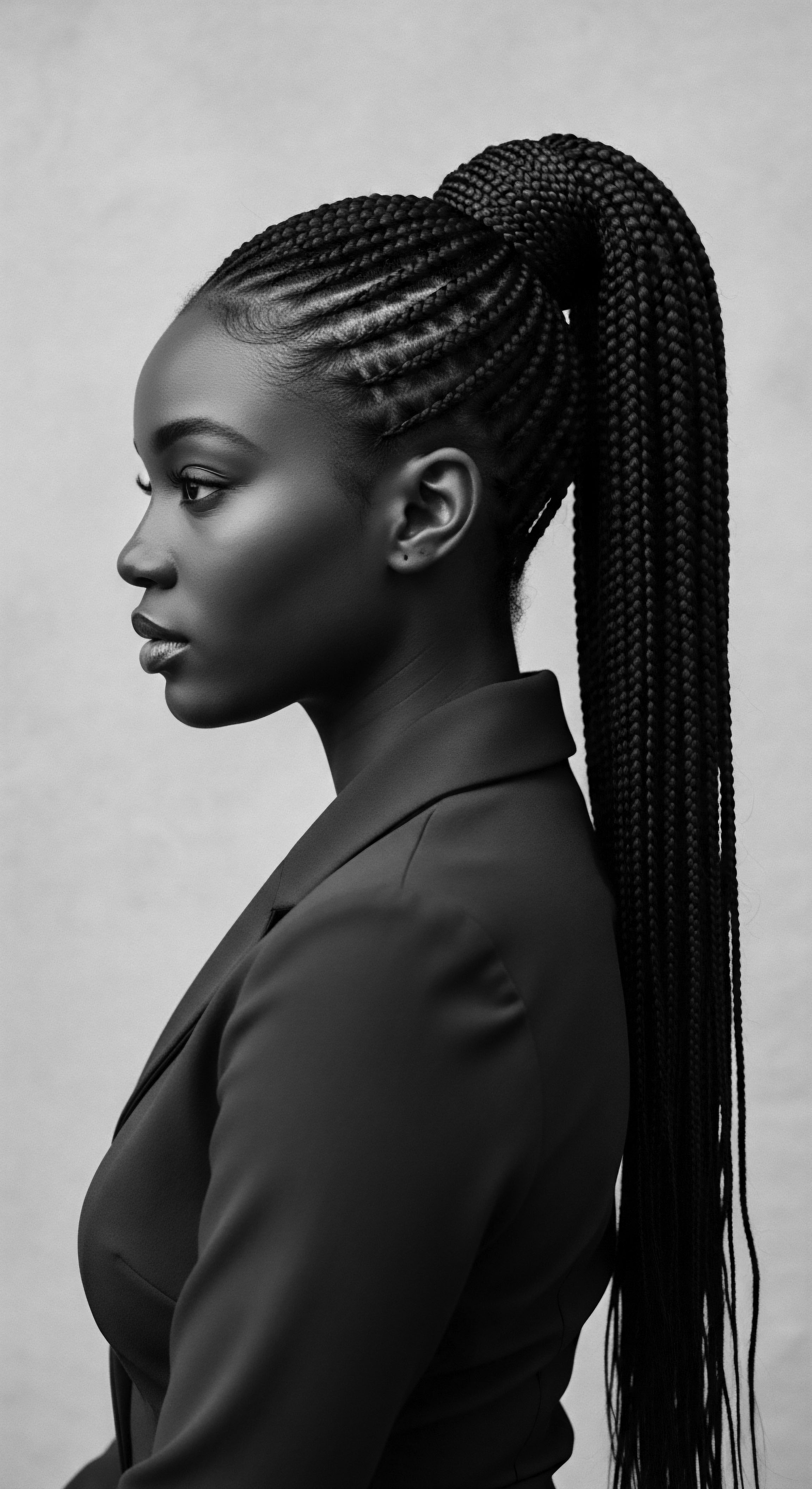
Fundamentals
The Shea Butter Use, at its most fundamental level, refers to the application and purpose of the creamy, lipid-rich substance derived from the nuts of the shea tree, known botanically as Vitellaria paradoxa. This tree flourishes across the Sahelian belt of West and Central Africa, a region where its fruits have nourished communities and its butter has served as a cornerstone of wellbeing for millennia. Its straightforward designation in the lexicon of natural care is a moisturizer and protective balm, prized for its ability to hydrate and soften.
The historical use of shea butter is deeply woven into the daily lives and ancestral practices of African communities. For countless generations, its presence has signified more than simple cosmetic utility; it has been a symbol of communal wealth, a staple in traditional medicine, and a central component of familial care rituals. The understanding of its qualities has been passed down through oral traditions and hands-on learning, particularly among women, who are the primary cultivators and processors of this remarkable natural resource.
Shea Butter Use, in its simplest form, is the traditional application of a nutrient-rich balm from the shea tree, revered for its profound moisturizing and protective qualities.
Across various cultures within the shea belt, the preparation of shea butter is a meticulous, labor-intensive process, traditionally performed by women. This artisanal journey from nut to butter involves harvesting, drying, crushing, roasting, grinding, and kneading. Each step requires skill and collective effort, transforming the raw shea nut into the golden-hued salve that holds immense value. This process is not merely a method of production; it represents a living legacy, a testament to inherited wisdom and sustainable interaction with the natural world.

Core Properties of Shea Butter
Shea butter possesses a unique chemical composition that lends itself well to its diverse applications. It is rich in fatty acids, including oleic acid, stearic acid, and linoleic acid, which contribute to its emollient properties. These lipids work in concert to form a protective barrier on the skin and hair, helping to seal in moisture and guard against environmental stressors. Additionally, shea butter contains vitamins A, E, and F, which are known for their antioxidant qualities and their role in promoting cellular health.
- Moisturizing ❉ The high fatty acid content allows shea butter to deeply hydrate hair strands and the scalp, preventing dryness and brittleness.
- Protective ❉ It creates a film that shields hair from harsh elements, such as sun and wind, and helps mitigate damage from heat styling.
- Softening ❉ Regular application contributes to a softer, more pliable hair texture, reducing frizz and improving manageability, particularly for textured hair.
- Soothing ❉ Its anti-inflammatory properties can calm an irritated scalp, addressing issues like dryness or flaking.

Ancestral Applications for Hair
For centuries, the use of shea butter for hair care has been a cornerstone of beauty rituals throughout West Africa. It served as a primary conditioning agent, a sealant for moisture, and a balm for scalp health. Traditional practices often involved warming the butter to facilitate its distribution through dense, coiled hair, ensuring every strand received its protective coating. This method not only provided physical benefits but also carried communal significance, as hair care was often a shared activity among women.
The understanding of shea butter’s capacity to maintain hair health in challenging climates was an intuitive knowledge, honed over generations. It was applied to strengthen hair, reduce breakage, and promote length retention, allowing for the creation of intricate hairstyles that were often markers of social status, age, or tribal identity. The deliberate act of applying shea butter to hair was a gesture of care, an acknowledgment of hair as a living extension of self and heritage.
| Aspect Extraction Process |
| Traditional Method (Ancestral Echoes) Labor-intensive, multi-step process involving hand-harvesting, sun-drying, crushing, roasting, grinding, kneading with water, and boiling. |
| Modern Method (Contemporary Adaptations) Often mechanical pressing (cold press or expeller) or solvent extraction, followed by refining and deodorizing. |
| Aspect Primary Producers |
| Traditional Method (Ancestral Echoes) Predominantly women in rural cooperatives, passing knowledge through generations. |
| Modern Method (Contemporary Adaptations) Larger commercial entities, though many still source from women's cooperatives. |
| Aspect Product Purity |
| Traditional Method (Ancestral Echoes) Typically raw, unrefined, retaining more natural nutrients and a distinctive aroma. |
| Modern Method (Contemporary Adaptations) Often refined, which can remove some impurities but may also reduce certain beneficial compounds. |
| Aspect The enduring legacy of traditional shea butter production continues to shape its value, emphasizing the profound connection between ancestral techniques and the quality of the final product. |

Intermediate
Expanding upon its fundamental definition, the Shea Butter Use signifies a profound interplay between biological efficacy and cultural resonance, particularly within the vast and varied landscape of textured hair heritage. It is not merely a substance applied to hair; it is a medium through which ancestral knowledge flows, a silent language spoken between generations, preserving traditions of care and adornment. This interpretation acknowledges the butter’s role as a biological agent that offers substantive benefits to the hair shaft and scalp, while simultaneously recognizing its deep symbolic meaning within Black and mixed-race hair experiences.
The intrinsic value of shea butter, often referred to as “women’s gold” in West Africa, extends beyond its market price. This designation reflects the economic empowerment it provides to millions of women who cultivate, harvest, and process the nuts, sustaining families and communities through a trade rooted in ancient practices. The revenue generated from shea butter sales has historically supported household needs, including education and healthcare, making its use a socio-economic pillar.

The Soul of a Strand ❉ Shea Butter and Textured Hair
Textured hair, with its unique structural characteristics of coils, curls, and waves, often requires specific care to maintain hydration and strength. The helical nature of these strands means that natural oils produced by the scalp find it more challenging to travel down the hair shaft, leading to increased susceptibility to dryness and breakage. This inherent biological reality makes the emollient and sealing properties of shea butter particularly advantageous. Its rich fatty acid profile provides a substantive layer of moisture, helping to mitigate the challenges posed by the hair’s architecture.
Shea Butter Use for textured hair embodies a continuous conversation between biological need and inherited wisdom, offering a balm that nourishes both the strand and the spirit.
For Black and mixed-race individuals, shea butter has served as a protective shield against environmental elements and a foundational element in styling. From protective braiding practices to intricate updos, shea butter provided the pliability and hold necessary to sculpt hair while simultaneously delivering conditioning benefits. This dual functionality highlights its enduring presence in hair care regimens that prioritize both health and artistic expression.

Cultural Significance Across the Diaspora
The movement of African people across the diaspora carried with it not only individuals but also their traditions, knowledge, and ingredients. While direct access to shea trees may have been limited in new lands, the memory and methods of using shea butter persisted, adapting to available resources. The yearning for ancestral ingredients and practices became a powerful act of cultural preservation and resistance, particularly in contexts where dominant beauty standards often marginalized textured hair. The re-discovery and re-integration of shea butter into hair care routines among diasporic communities represents a reclaiming of heritage, a conscious choice to honor ancestral wisdom.
This cultural meaning extends to rituals of care that transcend mere product application. The act of communal hair grooming, often involving the application of shea butter, served as a space for storytelling, bonding, and the transmission of identity. It was in these intimate moments that children learned about their hair, its history, and the profound connection to their lineage.
- Historical Trade Routes ❉ Prior to colonial influences, shea butter was a significant commodity traded across vast West African networks, reaching as far south as the Volta River in Ghana, exchanged for goods like salt and fish.
- Colonial Period Adaptations ❉ Despite colonial efforts to commercialize shea for European industrial uses, the local and regional trade by women persisted, ensuring its continued availability for traditional uses within communities.
- Diasporic Reconnection ❉ Contemporary movements towards natural hair care have seen a resurgence of shea butter’s prominence, serving as a tangible link to African roots and a symbol of self-acceptance.

The Science of Ancestral Wisdom
Modern scientific inquiry has begun to validate the long-held ancestral understanding of shea butter’s benefits. Research confirms its high concentration of triterpenes, tocopherols (Vitamin E), phenols, and sterols, which contribute to its anti-inflammatory, antioxidant, and regenerative properties. These compounds work synergistically to support scalp health, protect hair from oxidative stress, and promote a healthy environment for hair growth. The traditional methods of processing, often involving gentle heating and manual kneading, are now understood to preserve many of these delicate compounds, highlighting the intuitive wisdom embedded in ancestral practices.
| Traditional Observation Hair feels softer and more manageable. |
| Scientific Explanation High fatty acid content (oleic, stearic, linoleic acids) coats the hair shaft, reducing friction and enhancing smoothness. |
| Traditional Observation Protects hair from harsh sun and wind. |
| Scientific Explanation Forms a protective film, acting as a physical barrier against environmental aggressors, potentially offering mild UV protection due to cinnamic acid esters. |
| Traditional Observation Helps reduce breakage and promotes length retention. |
| Scientific Explanation Deeply moisturizes and seals the cuticle, minimizing dryness-induced brittleness and mechanical damage. |
| Traditional Observation Soothes itchy or flaky scalp. |
| Scientific Explanation Anti-inflammatory compounds like amyrin help calm irritation and support a healthy scalp microbiome. |
| Traditional Observation The profound efficacy of shea butter, long understood through ancestral practices, is increasingly affirmed by contemporary scientific investigation, revealing a harmonious alignment between tradition and discovery. |

Academic
The academic elucidation of Shea Butter Use transcends a mere functional description, positioning it as a complex socio-cultural construct interwoven with ethnobotanical knowledge, economic agency, and the very fabric of Textured Hair Heritage. Its scholarly interpretation demands an examination of its origins, its enduring role in sustaining West African women, and its subsequent re-appropriation within global beauty discourse, always with a critical lens on its ancestral foundations. This deeper understanding reveals the Shea Butter Use as a living repository of collective memory, traditional ecological wisdom, and an unwavering symbol of identity for Black and mixed-race communities.
The term ‘Shea Butter Use’ thus denotes the comprehensive engagement with Vitellaria paradoxa butter, encompassing its traditional production methodologies, its multifaceted applications for hair and skin, its historical economic significance, and its contemporary implications for cultural identity and wellness. This interpretation recognizes the butter not only as a natural product but as a historical agent, a commodity of profound cultural capital, particularly in the context of African and diasporic hair practices. The historical trajectory of shea butter is not linear; rather, it is a complex interplay of local ingenuity, colonial pressures, and global market dynamics, with its deepest meaning residing in the hands of the women who have always been its custodians.

Echoes from the Source ❉ The Ethnobotanical Roots and Traditional Production
The shea tree, or Vitellaria paradoxa, has been a central pillar of life in the Sahelian and Sudanian savannas for thousands of years. Archaeological evidence suggests the use of shea butter dates back over 3,000 years, with historical records indicating its presence in ancient Egypt, where figures like Cleopatra are said to have used it for skin and hair care. This deep historical presence underscores a long-standing human-plant relationship, where communities developed an intricate understanding of the tree’s lifecycle and the properties of its fruit. The term ‘Karité,’ meaning ‘tree of life’ in some West African languages, aptly captures its vital role, providing sustenance, medicine, and cosmetic benefits.
The traditional production of shea butter is a testament to indigenous knowledge systems and communal labor. It is an arduous, multi-day process almost exclusively carried out by women, who are considered the sacred keepers of this craft. This ancestral method, passed down through generations from mother to daughter, involves numerous stages ❉
- Harvesting and De-Pulping ❉ Women gather fallen shea fruits, typically between April and August. The fleshy pulp is removed, often through fermentation or manual peeling.
- Drying and Cracking ❉ The nuts are sun-dried, then cracked to extract the kernels.
- Roasting and Grinding ❉ Kernels are roasted over fires, which develops their distinctive aroma and facilitates oil extraction. They are then ground into a fine paste.
- Kneading and Washing ❉ The paste is mixed with warm water and vigorously kneaded by hand, a crucial step that separates the fat. This process can take hours and demands considerable physical strength and skill.
- Boiling and Skimming ❉ The resulting emulsion is boiled, allowing the pure shea butter to rise to the surface, where it is skimmed off and left to cool and solidify.
This traditional approach, while labor-intensive, yields unrefined shea butter that retains a higher concentration of its natural bioactive compounds, including vitamins A, E, and F, as well as triterpenes and cinnamic acid esters, which contribute to its anti-inflammatory and antioxidant properties. The meticulousness of this process is not merely for efficiency; it is a ritual of care, often accompanied by songs and storytelling, reinforcing communal bonds and cultural identity.

The Tender Thread ❉ Economic Agency and Hair Care Traditions
The economic dimension of Shea Butter Use is inseparable from its cultural significance. For millions of women across the shea belt, shea butter production represents a primary, often sole, source of income, earning it the moniker “women’s gold.” This female-dominated industry provides financial autonomy in communities where other opportunities are limited, enabling women to fund children’s education, healthcare, and improve overall family well-being. The United Nations Development Programme (UNDP) estimates that shea butter production provides income to an average of three million African women. This statistic underscores the profound socio-economic impact of the shea industry, which has historically been controlled by women, a rare instance of female economic sovereignty in many traditional economies.
The designation of shea butter as “women’s gold” reflects its profound socio-economic impact, empowering millions of African women through an industry rooted in ancestral knowledge and communal enterprise.
The proceeds from shea butter sales have long circulated within local economies, supporting a self-sustaining cycle of traditional livelihoods. This economic agency directly translates into the ability to maintain and transmit hair care traditions. With resources derived from shea, families could ensure access to the butter itself, as well as other complementary natural ingredients and tools necessary for the elaborate and time-consuming hair rituals common in many West African cultures. These rituals, which often involved intricate braiding, twisting, and coiling, were not simply aesthetic choices; they were profound expressions of identity, spirituality, and community.
A compelling historical example of Shea Butter Use’s connection to textured hair heritage and Black hair experiences can be observed in the pre-colonial and early colonial periods of West Africa. During the transatlantic slave trade, and even before, shea butter was a vital commodity traded over long distances. Historical accounts suggest that shea butter’s demand increased during the slave trade, as it was used as a moisturizer for Africans awaiting sale to Europeans. (Cowley, 1928, cited in Wardell et al.
2014, p. 5) This harrowing detail reveals a complex layer of its use ❉ even in the face of unimaginable dehumanization, shea butter served as a tangible link to ancestral practices, providing a measure of physical comfort and perhaps a psychological connection to home and identity amidst brutal conditions. This particular historical instance highlights how shea butter, beyond its physical benefits, held a deep, enduring meaning as a cultural touchstone and a source of solace for those experiencing profound displacement. Its application, even in such dire circumstances, represented a continuity of self-care practices inherited from generations.

The Unbound Helix ❉ Identity, Resilience, and Global Trajectories
The journey of Shea Butter Use from localized ancestral practice to a global commodity has been complex, often reflecting the broader dynamics of cultural exchange and appropriation. In the academic sphere, this evolution prompts critical inquiry into how traditional knowledge is valued, disseminated, and sometimes commodified. The increasing global demand for shea butter, projected to reach $5.58 billion by 2033, presents both opportunities for economic development in producing regions and challenges related to sustainability and equitable trade.
For textured hair communities worldwide, the renewed interest in shea butter represents a powerful reclamation of heritage. As natural hair movements gained momentum, shea butter became a staple, celebrated for its efficacy on coils, curls, and waves. This re-engagement with an ancestral ingredient is not merely about product preference; it is a conscious act of cultural affirmation, a rejection of Eurocentric beauty standards, and a celebration of indigenous African beauty traditions. The widespread availability and popularity of shea butter in contemporary hair care products allow individuals to connect with a lineage of care that predates colonial impositions, reinforcing a sense of belonging and pride in their unique hair textures.
The academic analysis of Shea Butter Use also delves into its biological mechanisms. The rich presence of triglycerides, particularly those containing oleic and stearic acids, gives shea butter its emollient and occlusive properties, forming a protective film that reduces transepidermal water loss from the scalp and hair shaft. Furthermore, its unsaponifiable fraction, rich in phytosterols, triterpenes, and tocopherols, contributes to its anti-inflammatory, antioxidant, and UV-absorbing capabilities. These components collectively support hair health by moisturizing, reducing oxidative stress, and maintaining scalp integrity, all of which are particularly beneficial for the inherent dryness and structural fragility often associated with highly textured hair.
The ongoing research into shea butter’s specific impact on melanin-rich hair follicles and scalp conditions continues to deepen our understanding, bridging the gap between centuries of empirical observation and contemporary scientific validation. This confluence of ancestral wisdom and modern scientific rigor offers a holistic perspective on the profound and enduring significance of Shea Butter Use within the realm of textured hair care.
One area of ongoing academic discussion concerns the optimal processing methods for shea butter to preserve its beneficial compounds. While traditional methods are labor-intensive, they often yield unrefined butter that retains a higher concentration of vitamins and unsaponifiable matter compared to highly refined industrial versions. This leads to conversations about supporting fair trade practices that empower women’s cooperatives, ensuring both the authenticity of the product and the equitable distribution of its economic benefits. The choice to use unrefined, ethically sourced shea butter becomes a conscious act of supporting ancestral legacies and sustainable community development.
| Aspect of Use Daily Hair Moisturization |
| Connection to Heritage and Identity Reinforces traditional practices of maintaining hydrated, pliable textured hair, a hallmark of ancestral care. |
| Aspect of Use Protective Styling Base |
| Connection to Heritage and Identity Enables intricate braiding and twisting, styles that have historically conveyed social status, tribal affiliation, and spiritual meaning. |
| Aspect of Use Scalp Health Maintenance |
| Connection to Heritage and Identity Upholds the holistic view of hair care, where a healthy scalp is the foundation for strong hair, mirroring ancient wellness principles. |
| Aspect of Use Ingredient in Homemade Formulations |
| Connection to Heritage and Identity Continues the legacy of self-sufficiency and bespoke care, drawing upon inherited recipes and intuitive understanding of natural ingredients. |
| Aspect of Use The multifaceted use of shea butter in hair care is a tangible expression of cultural continuity, connecting contemporary practices to a rich ancestral past. |

Reflection on the Heritage of Shea Butter Use
The journey through the Shea Butter Use, from its humble origins in the West African savanna to its global presence, is truly a profound meditation on Textured Hair Heritage. It is a narrative that speaks not only of a natural ingredient but of the enduring spirit of communities, particularly women, who have nurtured this sacred tree and its gifts for millennia. The ‘Soul of a Strand’ ethos finds its living embodiment in the golden richness of shea butter, a substance that has cradled, protected, and celebrated the unique contours of Black and mixed-race hair through countless generations.
From the whispers of ancient rituals, where shea butter anointed newborns and adorned royalty, to the resilient hands of women’s cooperatives today, the thread of its meaning remains unbroken. This butter carries within its creamy texture the stories of survival, creativity, and self-definition. It reminds us that care for textured hair is not a modern invention but a deeply rooted ancestral practice, a legacy of ingenious adaptation to environment and an unwavering commitment to self-preservation and beauty.
The Shea Butter Use, in its complete sense, invites us to look beyond the surface of a product and see the deep cultural wisdom it holds. It is a call to honor the ancestral practices that recognized its potency long before scientific validation, to support the communities who remain its primary custodians, and to understand our own hair’s journey as a continuation of a grand, vibrant history. As we continue to learn from the echoes from the source, appreciate the tender thread of care, and witness the unbound helix of identity, shea butter stands as a timeless testament to the beauty, strength, and enduring heritage of textured hair. Its story is our story, a reminder that the deepest forms of wellness are often found in the wisdom passed down through time.

References
- Cowley, L. (1928). Shea Butter ❉ Its Production and Use. Colonial Plant and Animal Products.
- Naughton, M. Lovett, P. N. & Mihelcic, J. R. (2015). The Shea Tree (Vitellaria paradoxa) in West Africa ❉ A Review of its Ecology, Production and Uses. Agroforestry Systems.
- Wardell, D. A. T. Fold, & T. Lovett. (2014). Shea (Vitellaria paradoxa CF Gaertn.) – a peripheral empire commodity in French West Africa, 1894-1960. African Economic History.
- Ehret, C. (2002). The Civilizations of Africa ❉ A History to 1800. University Press of Virginia.
- Lewicki, T. (1974). West African Food in the Middle Ages ❉ According to Arabic Sources. Cambridge University Press.
- Park, M. (1983). Travels in the Interior Districts of Africa. Eland Books. (Original work published 1799).
- Barth, H. (1968). Travels and Discoveries in North and Central Africa. Frank Cass. (Original work published 1857).
- Newbury, C. W. (1972). The West African Commonwealth. Duke University Press.
- Milbourn, S. (1970). The Palm Oil Industry of West Africa. Oxford University Press.
- Lynn, M. (1998). Commerce and Culture in the Nineteenth-Century West African Trade. Cambridge University Press.
- Silver, J. (1981). The Gold Coast and the Ashanti Goldfields ❉ A Study of British Colonial Economic Policy. University of California Press.
- Arhin, K. (1972). The Economic and Social Aspects of the Trade in Rubber in Ghana. University of Ghana.
- Carney, J. A. & Elias, S. (2006). Gendered Landscapes ❉ The Social and Ecological Impacts of Development Initiatives in West Africa. Blackwell Publishing.
- Levtzion, N. & Hopkins, J. F. P. (Eds.). (2000). Corpus of Early Arabic Sources for West African History. Markus Wiener Publishers.
- Terpend, G. (1982). The Shea Tree ❉ A Multipurpose Tree in West Africa. International Development Research Centre.
